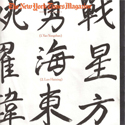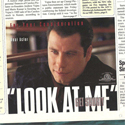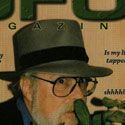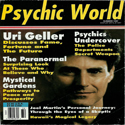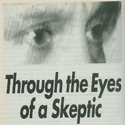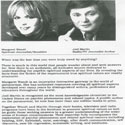
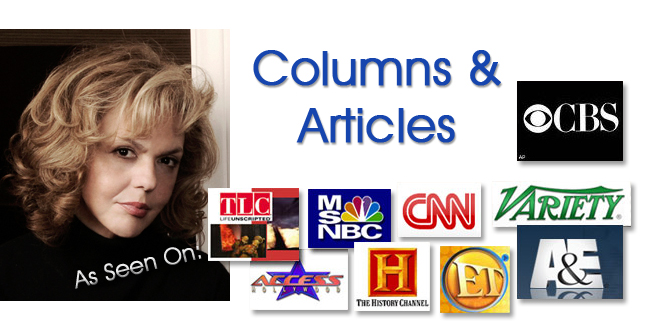
You will need to have Adobe Acrobat Reader installed to view the UFO articles. Download it from here.
Articles
Dreams and disaster happening at the same time.

Dr. Antonio de Nicolas' brother has just been elected the 30th Superior General of the Society of Jesus! History is made! Click here.
New superior urges Jesuits to strengthen service to poor. Click Here
Province Express - Father Adolfo Nicol�s. Click Here
- Is a New Eugenics Afoot? by Garland E. Allen
- The 1929 Arab Terror Attack: When Hebron Became Occupied Territory by Sammy Benoit
- "Saturn enters Libra"
- 'I am sorry,' Cardinal Mahony says amid new priest abuse details
- 04/07/08 We are all African
- 04/23/08 Moody's Blues
- 05/06/08 Lunacy and Freedom
- 05/10/08 It's not easy being Green, or even truthful it would seem
- 05/21/08 Shareholder Value
- 05/26/08 Senator Clinton, Fear, and Assassination
- 06/02/08 The Lesson Derived From Derivatives
- 06/12/08 The Price of Ice Cream
- 06/23/08 The Market
- 06/25/08 Getting Hit By A Bus
- 07/11/08 Being Right
- 07/18/08 Einstein
- 07/18/08 Karma
- 07/21/08 Ecology, Security and Economics
- 08/01/08 Who We Have Been Waiting For
- 08/11/08 From The Head To The Heart
- 08/20/08 Incarceration
- 08/28/08 Frick and Frack
- 09/10/08 Worrying
- 09/17/08 Taxpayer Bailout
- 10/16/08 Deleveraging
- 11/23/08 Too Big to Survive
- 11/24/08 Getting Hit By a Bus
- 2014: Sag New Moon --Change that perspective-NOW!
- 2024 Capricorn New Moon: Let's Get Your Cap On!
- 2nd Aquarius New Moon: 2015
- ACE OF CUPS
- ACE OF PENTACLES
- ACE-OF-SWORDS
- ACE-OF-WANDS
- After Lehman
- Amazing New Video -- The 2012 Enigma! by David Wilcock
- An Extraordinary Astrological Recapitulation by Brian McNaughton
- And now it is the Second Cancer New Moon!
- Aqaurius New Moon 2011--The New Quilting BEE!
- Aquarius New Moon 2010! It is a strange trip
- Aquarius New Moon 2012!
- Aquarius New Moon 2014 - You LikeMind me.
- Aquarius New Moon 2015 - The Zero One
- Aquarius New Moon 2016: Get Your Tribe On
- Aquarius New Moon 2017: Out of the chaos we find our Peeps.
- aquarius New Moon 2017: Out of the chaos we find our Peeps.
- Aquarius New Moon 2017: Out of The Chaos We Find our Peeps!!
- Aquarius New Moon 2018: Friends & Communities
- Aquarius New Moon 2019: No Time or Place for Emotions
- Aquarius New Moon 2020: Expect the Unexpected
- Aquarius New Moon 2021 Your Place in the Community
- Aquarius New Moon 2022: Loneliness or Circles? Your choice!
- Aquarius New Moon 2023: Wear Your Weird
- Aquarius New Moon 2024: Pluto is Getting Our Attention
- Aquarius New Moon 2025
- Aquarius New Moon--Unique Solutions if you are willing
- ARCHANGEL MICAHEL: SOUL'S JOURNEY
- ARCHANGEL MICHAEL: FAMILY AND FRIENDS
- Archangel Michael: INTENTIONS
- ARCHANGEL URIEL: STRESS
- Archangels: Stress
- Aries New Moon #1 March 2023
- Aries New Moon #2 - April 19th 2023 PDT
- Aries New Moon - It will be a great Treasure Map time!
- Aries New Moon 2009---IT’S A BIG ONE!
- Aries New Moon 2010--Let's get this party started!
- Aries New Moon 2012: You rule!
- Aries New Moon 2014 Get out of the way! Your Life is Coming
- Aries New Moon 2016: Light this rocket!
- Aries New Moon 2017
- Aries New Moon 2018: What Are Your Instincts Telling You?
- Aries New Moon 2019: Patience. Yes. That Word.
- Aries New Moon 2020: Survival
- Aries New Moon 2021: Heart Driven Changes
- Aries New Moon 2022: Finding Self Now!
- Aries New Moon 2024 Total Solar Eclipse - Wow.
- Aries New Moon 2025: A New Beginning for All
- Aries New Moon! (2008) by Tracy Cook
- Aries New Moon, 2011- Yes it is a big one!
- Article by Jock Brocas
- Back on Uncle Sam's Plantation
- Being Frugal and Benefiting
- Biomass-Eating Military Robot Is a Vegetarian, Company Says
- Bob Dylan: Like a Complete Unknown by Ron Radosh
- Books mentioned in Brian Hurst's broadcasts
- Britain Hired Astrologer to Fight Hitler
- Buddhism and the End of Economic Growth by John Stanley & David Loy
- Cancer Eclipse & New Moon 2019: Your Emotions Will Guide You
- Cancer New Moon & The Grand Cross
- Cancer New Moon --The Great Healing by Tracy Cook
- Cancer New Moon 2010---Your feelings have answers
- Cancer New Moon 2012 - "It's the flow, Baby!"
- Cancer New Moon 2014: REFRESH!
- Cancer New Moon 2016: Let It Flow
- Cancer New Moon 2017: Are your emotions flowing? Good.
- Cancer New Moon 2023: Ride the Rapids
- Cancer New Moon 2024: Emotions, Feelings and Needs- Oh, My!
- Cancer New Moon Solar Eclipse June 20, 2020
- Cancer New Moon--The first of two (2009)
- Cancer New Moon-Ready, Set, Emote! July, 14th 2007 by Tracy Cook
- Cancer New Moon: 2013
- Cancer New Moon: 2022 - Emotions Guide Us To Our Heart
- Cancer New Moon: Don't make me go find your roots...you do it!
- Cancer New Moon: Feelings. Emotions. Passion. 2021
- Cancer Solar Eclipse 2018
- Capricorn 2010 NEW MOON--Taking Care of Business!
- Capricorn 2011-Aim your ambition-NOW
- Capricorn New Moon - Get Serious!
- Capricorn New Moon 2011 -Be the authority and move up!
- Capricorn New Moon 2013: Pragmatic and no excuses
- Capricorn New Moon 2014
- Capricorn NEW MOON 2016 ...Get Real!
- Capricorn New Moon 2018
- Capricorn New Moon 2019 - Pragmatism Pragmatism Pragmatism
- Capricorn New Moon 2019: Focused and Disciplined
- Capricorn New Moon 2019: Focused and Disciplined
- Capricorn New Moon 2021. Climb Like a Goat
- Capricorn New Moon 2022: Climb Heights
- Capricorn New Moon 2025 Ambition for You
- Capricorn New Moon Dec 2022: CEO of Values
- Capricorn New Moon: Slow and sensible is a-okay.
- Children Skipping Childhood
- Clean your Slate Capricorn New Moon! by Tracy Cook
- Compliments Do You Get Enough Of Them?
- David Kaiser from MIT, not David Kaiser from the Naval War College
- Detach From Rescuing
- Did Yale prostitute itself for oil money? by Ethel C. Fenig
- Do I Remember Differently Than Another Does?
- Do you feel good about where you live? by Jill Saint James
- Dreaming on Pisces New Moon by Tracy Cook
- ECSTASY
- Energetic Health Food By Eva Sanchez,N.D.
- Face The Music
- Fox Blowviator Bill O'Reilly wants you to hate him
- GEMINI NEW MOON 2011 –“Can someone turn on the air, please?”
- Gemini Eclipse New Moon 2021: Fact versus Fiction and Pivot !
- Gemini New Moon (2012)- Second time's the charm
- Gemini New Moon 2009---The Fast and Furious Talker
- Gemini New Moon 2010: A Tornado among us!
- Gemini New Moon 2013
- Gemini New Moon 2014: The power of light feet
- Gemini New Moon 2014: The power of light feet
- Gemini New Moon 2018 - Thoughts!
- Gemini New Moon 2019: Mix it up & Adapt
- Gemini New Moon 2020: Reboot Your Inner Computer
- Gemini New Moon 2022: Process the Information
- Gemini New Moon 2023: Fuzzy Data But Still Informs
- Gemini New Moon 2024: Cha-Cha-Cha-ing
- Gemini New Moon by Tracy Cook
- Gemini New Moon-- Reach out! Mix it Up!
- Gemini New Moon--the first round- 2012
- Gemini New Moon. Mental Exercises 2015
- Gemini New Moon. Mental Exercises 2015
- Gemini New Moon: Question and Shift
- Gemini- New Moon 2008-- Ready to Connect! by Tracy Cook
- Get out of the way---LEO NEW MOON is HERE!
- Get your Viking on--Aries New Moon 2013
- Getting the Scoop by Janet Donovan
- Glossary of Number Values
- God + Faith by Margaret Wendt
- God Heard The Need
- Headaches are Telling You Something by Eva Sanchez, N.D.
- Heart Ethics by Way of Introduction by Dr. Antonio T. de Nicolas, PHD
- Hi Ho Silver!!
- History Unfolding by David Kaiser
- How American corporate philanthropies launched a national campaign of ethnic cleansing in the United States, helped found and fund the Nazi eugenics of Hitler and Mengele — and then created the modern movement of "human genetics." by Edwin Black
- How to sit with a medium
- I Forgot To Accept The Things I Can Not Change
- I Want Your Help, I’m An Atheist
- In a generation or two, the US will ask itself: "Who lost Europe?"
- In fallout from crisis, rethinking risk and human judgment by Lynnley Browning
- Incredible information and facts about the paranormal and publishing
- Is A Shift Needed in Parenting Values?
- Is Your Community Antisocial?
- It is all a balancing act, Baby! Libra new moon 2008
- Jess Stearn
- JFK Junior - John Jr. by Sloan Bella
- Jon Bennett Ramsey by Sloan Bella
- Keeping a Tally Sheet
- Kurt Cobain - Celebrity Channel by Sloan Bella
- Learn about Boundaries
- Lemon for Lymph By Eva Sanchez N.D.
- LEO 2008 New Moon--Sunny side of the street by Tracy Cook
- Leo New Moon - Round two & Solar Eclipse 2017
- Leo New Moon - The First One! 2017
- Leo New Moon - The First One! 2017
- Leo New Moon - To be bold or not to be bold? That is the question
- Leo New Moon 2011--Your passion tells you so
- Leo New Moon 2012--The Heart Wants To Thrive
- Leo New Moon 2013: Be Big. Be Very Big
- Leo New Moon 2015: Learn from the Lion!
- LEO NEW MOON 2016: Dare to find Joy & Strength
- Leo New Moon 2019: Be Special, dang it!
- Leo New Moon 2020: Put on Your Sloppy Cape
- Leo New Moon 2023 - 29 Days of Brave
- Leo New Moon 2024: Love, Strength and Courage
- Leo New Moon Eclipse 2018
- Leo New Moon: 2021 - Find Your Authentic Heart
- leo New Moon: 2021 - Find Your Authentic Heart
- Leo New Moon: 2022 - Be YOU.
- Leo's in the House..Roar! Sort of.. by Tracy Cook
- Libra New Moon (2007) by Tracy Cook
- Libra New Moon -How do you relate? Does it serve you?
- Libra New Moon 2009--The business of relating
- Libra New Moon 2012-
- Libra New Moon 2013 -- Balance That!
- Libra New Moon 2014: Let's really get our Libra on this time
- Libra New Moon 2015: Get your relationships straightened out
- Libra New Moon 2016: The Power of Negotiation
- Libra New Moon 2017: Not as light as you think
- Libra New Moon 2018: Power & Negotiations & Self Worth. Repeat.
- Libra New Moon 2019: Your Identity, My Identity & An Oxygen Mask
- Libra New Moon 2020: Bumpy. Power. Kindness. Repeat.
- Libra New Moon 2021: Where's your balance?
- Libra New Moon 2022 : How are your relating skills?
- Libra New Moon Eclipse 2023
- Libra New Moon Eclipse 2024: What's That Zagging?
- Look In My Eyes
- Love in the Land of Loneliness by Joseph Dispenza
- Marilyn Monroe - June 2004 - Celebrity Channel by Sloan Bella
- MAY GOD BLESS THIS AIRLINE CAPTAIN
- Me Controlling
- Meditation: The Making of Images By Antonio T. de Nicolas, PhD
- Mindy Sommers
- Mirror Mirror On The Wall
- My Global Warming Epiphany by Randall Hoven
- Narcissistic Behavior Is Increasing
- Neediness
- Nevins Rules by Julie Salamon
- New Moon in Aquarius 2013 Pull out your lightening rod-hits are coming
- New Moon in Virgo--Now you can fix your life
- New Moon Leo 2010--Wish upon a star--"Hey, that's me!"
- No One Mention The War!
- Pass The Buck
- Patience is a Virtue
- Pisces 2021 New Moon - All We Need is Love
- Pisces New Moon 2010--The LEAP of FAITH
- Pisces New Moon 2012: What is Dissolving?
- Pisces New Moon 2013 -Get in the flow
- Pisces New Moon 2014: Go for the Flow
- Pisces New Moon 2015
- Pisces New Moon 2016: Karma and Elevation
- Pisces New Moon 2017 -- The Big Release and Melt
- Pisces New Moon 2018: Intuition Speaks Are You Hearing It?
- Pisces New Moon 2019: Dazed and Confused --Thank You For It
- Pisces New Moon 2020: Time to Get Quiet
- Pisces New Moon 2022: Finding the Inner World
- Pisces New Moon 2023: Beep!
- Pisces New Moon 2024: Connecting to Bigger
- Pisces New Moon 2025: Unplug and Replenish
- Pisces New Moon---Mystics Apply
- Pisces New Moon--Dive or wash up on shore, it is your choice!
- Private Space Is Healing
- Psychic portraits of the Bangs Sisters
- Psychics, Mediums, and Rock N Roll
- Raymond Moody
- Re-wounding
- Re: Mars turns retrograde as Jupiter conjuncts Neptune on the Winter Solstice
- Re: Planetary Forecasting Methods for Traders
- Re: Saturn turns retrograde; Solar Eclipse; Mercury turns direct; Jupiter enters Pisces
- RESPOND TO RESPONSIBILTY-CAPRICORN NEW MOON 2008
- Responsibility Came From Being Told No
- Robert Monroe
- Sag New Moon 2010-- Ready, Aim---Change!
- Sag New Moon 2012 - A time to get real
- Sag New Moon 2021 Total Eclipse
- Sag New Moon 2023: Bits of Joy is still Joy
- Sag New Moon Total Eclipse 2020: The Truth is in The Mirror
- Sag New Moon---All Vision without the Hype!
- Sagittarius New Moon 2009--Ready, Aim, Adjust...Fire, Adjust, Aim, Ready..
- Sagittarius New Moon 2013 - Forward Ho!
- Sagittarius New Moon 2015: The Adventure!
- Sagittarius New Moon 2016: Get Wise Get Inspired
- Sagittarius New Moon 2017 - On Top of The Galactic Center
- Sagittarius New Moon 2018 - Get Inspired. Now!
- Sagittarius New Moon 2019: Hot & Cold Wisdom
- Sagittarius New Moon 2024: Finding The Way
- Sagittarius New Moon--Mother Knows Best
- Scorpio New Moon (2017) : Act Like a Plumber!!
- Scorpio New MOON 2009-Resources and Community--Where do I fit?
- Scorpio New Moon 2010-Jump in the water!
- Scorpio New moon 2012: Suit up and Commit
- Scorpio New Moon 2015
- Scorpio New Moon 2016: Release the death grip
- Scorpio New Moon 2018 - Rejuvenate!
- Scorpio New Moon 2019 - Shocked to Vulnerability
- Scorpio New Moon 2020: Dig Deep & Get Rid of Debris
- Scorpio New Moon 2023: Depth & Release
- Scorpio New Moon 2024: Tapping Power & Getting Unstuck
- Scorpio NEW MOON by Tracy Cook
- Scorpio New Moon Solar Eclipse SHED! SHED!SHED!
- Scorpio New Moon(2011)--DNA, Survival and ditching Garbage
- Scorpio New Moon: Get Your Plumbers Butt On!
- scorpio New Moon: Get your Plumbers Butt on!
- Scorpio New Moon: Solar Eclipse 2014
- scorpio New Moon: Solar Eclipse 2015
- Scorpio Solar Eclipse New Moon 2022: Release. Got it?
- Second Cancer New Moon 2020
- Sharia rejects all fundamental premises
- Speaking From Experience
- Speech by Lou Pritchett
- SURE RELATIONSHIPS BITE--BUT WE'RE ALL HUNGRY. Libra New Moon 2010
- Taurus New Moon 2008!
- Taurus New Moon 2010-----And so we begin.......
- Taurus New Moon 2011--Build upon it!
- TAURUS NEW MOON 2012 --What do you value?
- Taurus New Moon 2017: Practicality for a Personal Revolution
- Taurus New Moon 2018: Making Changes Bit by Bit
- Taurus New Moon 2019: Feel The Changes
- Taurus New Moon 2020: The rest of the year and being practical
- Taurus New Moon 2021. Slow down and find your values.
- Taurus New Moon 2022: Our Resources, our Love our Values!
- Taurus New Moon 2024: The Power of Slowing Down
- Taurus New Moon Eclipse: Yes you can make the changes!
- Taurus New Moon. Getting Practical ..Seriously, for real
- Taurus New Moon: May 19 The Glory of Practicality!
- Taurus New Moon: 2025 - Finding Stability In Extraordinary Times
- Taurus New Moon: Take the short route between A&B
- Taurus to the RESCUE!
- TaurusNewMoon 2014--Building Good bit by bit
- The Alinskyite's Big, Fat Governance Failure by Kyle-Anne Shiver
- The collapse of the U.S. Dollar and Federal Reserve? by Ted Phillips
- The coming collapse of the U.S. Dollar and Federal Reserve?
- The Consoling Angel by Antonio de Nicolas
- THE EMPEROR
- THE EMPRESS
- THE FOOL- MAJOR ARCANA
- The Ghosts on Moaning Mountain
- THE HEIROPHANT
- THE HIGH PRIESTESS
- The Horrifying American Roots of Nazi Eugenics by Edwin Black
- THE MAGICIAN- MAJOR ARCANA
- The Most Important Astrological Chart for Your Financial Security
- The Nightmare of Rationing in Oregon by Jeff Emanuel
- The Price of Ice Cream by Bill Sharon
- The Promise of the Past by Betty J. Kovács, Ph.D.
- The Reincarnation of Edgar Cayce and His Soul Group? - You Decide.
- The Sea has changed---SCORPIO NEW MOON 2008
- The Shadow and Karma
- The Spiritual Candle
- The Thieves of Happiness
- There she blows!!! SAG NEW MOON is HERE! by Tracy Cook
- Thomas Edison's Paranormal Personality by Margaret Wendt
- Thomas J. Curry must Leave Santa Barbara
- Tick Tock Virgo New Moon Strikes the Clock....2008
- Time To Connect With Like Minds
- Too Much Of A Good Thing....Is It Really Wonderful?
- Treasure Mapping by Tracy Cook
- Verbal Abuse Hurts
- Virgo 2018 New Moon - A Hero's Journey
- Virgo 2019 New Moon - A Car Full of Nerves
- Virgo New Moon - Your daily life is YOU. How is it going?
- VIRGO NEW MOON --GET YOUR MICRO ON!
- Virgo New Moon 2011- Help & Work serve you!
- Virgo New Moon 2012: Sweating the Small Stuff
- Virgo New Moon 2013: A Big Opportunity
- Virgo New Moon 2016 - What's that stuff in your schedule?
- Virgo New Moon 2017: Skills Needed! Please Apply
- Virgo New Moon 2021: Daily efforts build your life
- Virgo New Moon 2022: Don't be a burnt out Roomba
- Virgo New Moon 2023: Keep Your Head Down & Do The Work
- Virgo New Moon by Tracy Cook
- Virgo New Moon--Details Rule
- Virgo New Moon: 2020 - Every choice is yours
- Virgo New Moon: 2024 - Control Your Future By Your Schedule
- Vowels by Jill Saint James
- What Does Cutting Back On Expenses Mean To You?
- What Is A Distraction?
- What To Do This Taurus New Moon by Tracy Cook
- Where have all of the leaders gone? by Lee Iacocca
- Who Has Time To Read?
- You Feel Their Pain
- You had me at Hello, Aquarius New Moon by Tracy Cook
- You Lose Out When You Judge a Book by Its Cover
- You Make The Choice I Don't Care
- ‘Transce-end’ the trance – Bring out your dead!
- Uri Geller
- Margaret and Joel
- Houdini
Letters Sent to Us from the Public
- The 1929 Arab Terror Attack: When Hebron Became Occupied Territory by Sammy Benoit
- Biomass-Eating Military Robot Is a Vegetarian, Company Says
- Bob Dylan: Like a Complete Unknown by Ron Radosh
- Buddhism and the End of Economic Growth by John Stanley & David Loy
- David Kaiser from MIT, not David Kaiser from the Naval War College
- Did Yale prostitute itself for oil money? by Ethel C. Fenig
- History Unfolding by David Kaiser
- My Global Warming Epiphany by Randall Hoven
- The Alinskyite's Big, Fat Governance Failure by Kyle-Anne Shiver
- The collapse of the U.S. Dollar and Federal Reserve? by Ted Phillips
- The Nightmare of Rationing in Oregon by Jeff Emanuel
- Where have all of the leaders gone? by Lee Iacocca
Articles by Joel Martin
- Through the Eyes of a Skeptic
- Question and Answers
- Who Believes in the Paranormal?
- Nancy Reagan
- Ghost Ship
- I'm gonna get you 'suckers'
- Margaret Wendt and Joel Martin's New Book
Articles by Margaret Wendt
Paper Media: click thumb (where applicable) for full size image/.pdf files

Margaret's Magazine 1
Margaret's Magazine 2
Margaret's Magazine 3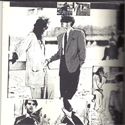
Margaret's Magazine 4
Margaret's Magazine 5
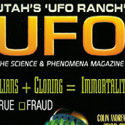
News Anchor's
UFO experience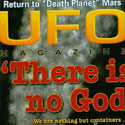
My Favorite Martian
Article by M. Wendt
Robert Urich
Spirit Magazine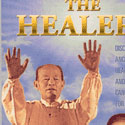
The Healers Magazine
Entertainment Tonight
Magazine for Cleveland
- News Anchor's UFO Experience by Margaret Wendt
- My Favorite Martian by Margaret Wendt
- Looking for Love by Margaret Wendt
- God + Faith by Margaret Wendt
- Thoms Edison's Paranormal Personality by Margaret Wendt
- Margaret and Joel
- Who was Hayim Solomon?
- Nevins Rules by Julie Salamon
- Psychic portraits of the Bangs Sisters
- Psychics, Mediums, and Rock N Roll
- The Ghosts on Moaning Mountain
- The Spiritual Candle
- Thomas Edison's Paranormal Personality by Margaret Wendt
- Margaret Wendt and Joel Martin's New Book
Heart Ethics by Way of Introduction by Dr. Antonio T. de Nicolas, PHD
Indoctrinated, as we are, into making decisions, even those on which our lives depend, based on the management of head ethics, to resurrect now heart ethics and the individual will might sound, at best, a sentimental journey into the past or, at worse, a misguided enterprise. And yet, head ethics, our rational faculty, is only aware of five per cent of our inner and outer human life, it has no access to the outside world, it selects from the right hemisphere of the neo-cortex what pleases its own interests, and justifies itself with logics that have no bases in any other reality than its own abstractions. Furthermore, this head ethics, is based on the only one of our faculties capable of lying, of dividing communities into opposing individuals, of justifying all and any form of violence to those same individuals, communities and even nations. But basically, head ethics lacks “biology.” It always refers to universals, empty of flesh, of biology, of movement, in a word, of individual human life. It is a virtual world. Head ethics is unethical in its own conception, and the source of reincarnation and mortality. Immortality is imprinted, through our decisions, in the walls of the heart.
Heart ethics was originally the way of decision making the ancients used to make their lives. Its history and narrative extends from the Rig Veda, the first Indo-European book ever written (3.000 B.C.), to Plato (died 347 B.C.), the last philosopher to base philosophy on heart ethics. It is only now, with the discoveries of modern neurobiology, that heart ethics may be understood and its implications taken to heart. It is written down in the memory of the species. It has the traces of divinity in it. It is earlier than the written word. It is lodged in the individual heart. It is the path of immortality, the path of no return to the discontinuous.
The Rig Veda already signals the two paths, two choices, humans have facing them, that of the fathers, based on procreation, and that of the gods, based on the heart. In our Western culture we were left with only one path, that of procreation, and with the exception of a few mystics, the heart was totally ignored. Modern neurobiology has made the distinction real again and it has made clear that if we follow the path of the fathers, procreation, we become addicted to the rushes of dopamine, (sex), but if we follow the ethics of the heart we may live in communal harmony and spiritual highs bathed in the joys of oxytocin without addiction, and experience the immortal even in this discontinuous life. We have traces of this dichotomy in early Greek mythology too.
W.B. Yeats in the first song of the "Two Songs from a Play" abruptly summarizes the plight of human action, the scholar's included:
I saw a staring virgin stand
Where holy Dionysus died,
And tear the heart out of his side,
And lay that heart upon her hand
And bear that beating heart away;
And then did all the Muses sing
Of Magnus Annus at the spring,
As though God's death were but a play.
Dionysus, as you will remember, was the "twice born" son of Zeus. As Zagreus, born of Zeus and Persephone, he became his father's favorite and placed above all the gods of
thunderbolt. From those ashes humans were born, but also Athena found the still- beating heart of Zagreus. Zeus took the heart, ground it up, put it in a drink, and gave it to mortal Semele to drink. Of this union Dionysus, the " twice born", the god born of the heart, the son of god, the god of death and resurrection, the child-god, the one that enters into Heaven ( Matthew l8, l-6), came into being. But the Titans came back and buried this heart under layers and layers of ethical simulacra. Who can rescue the original, beating, individual, immortal heart?
In trying to frame a context for human acting after the year 2000 a host of questions arise in view of the literature of the past, and the human desensitization of the present. Let’s try some. Given the fact that Christianity, for example, the greatest propagandist of our current ethics, took literally from earlier literatures the god of death and resurrection, the immortal human-divine god of the heart, why did it not take from these earlier cultures also the literature of the heart as real but took it instead as a mere metaphor? And does it make sense that when the Jesus of Christianity is grafted to the mind set that invented the ethics of the head He had to be given a genealogy that in order to be legitimate had to link historically, in an uninterrupted line of sperm transmission, to another human, like David, or a God, like Yahweh? ( Was Yahweh the father of Jesus? And is this also the reason why in Christianity women were relegated because they have no soul- sperm?) And why did our head-ethics claim an original and exclusive Revelation in proclaiming the Ten Commandments as the fountainhead of our ethics when in fact these commandments are the creative summary of the earlier Law Code of Hammurabi, c. 1792-1750 B.C.? (Is there a connection between our ways of thinking and the ethics we proclaim as revelation?) And if we were borrowing from the mythic past why did we not go a lot earlier, to around 3.000 B.C. to the Egyptian Pantheon and borrow the 42 declarations, negative confessions, of an Egyptian weighing his/her heart against the feather of truth of Maat:
I have not been a man of anger;
I have done no evil to mankind;
I have not inflicted pain;
I have made none to weep;
I have done violence to no man;
I have not done harm unto animals;
I have not robbed the poor;
I have not fouled water;
I have not trampled fields;
I have not behaved with insolence;
I have not judged hastily;
I have not stirred up strife;
I have not made any man to commit murder for me;
I have not insisted that excessive work be done for me daily;
I have not borne false witness;
I have not stolen land;
I have not cheated in measuring the bushel;
I have allowed no man to suffer hunger;
I have not increased my wealth except with those things
that are my own possession;
I have not seized wrongfully the property of others;
I have not taken milk from the mouth of babes. ( Budge, DN 254)
Compare again these heart confessions to the goddess Maat to those vengeful commands of the patriarchal gods of later on, like Deuteronomy 28:15-68. In view of the unethical behavior in history of the followers of the ethics of the head, in view also of the fact that our traditional ethics do not hold our human behavior in synchronicity with others or within ourselves, isn’t it time to look at least once at the possible ethics of the heart? Isn’t it the heart, love, the origin we claim, of our Religions, our families? There are, also, other more important questions we could be asking. What does this mythic heart have that it becomes the origin of the gods, from the Indic Rig Veda to Plato, the fire-pit (zagra) from where gods are born, the chamber where humans find again immortality, once they are reborn? Why does Ignatius de Loyola end his Spiritual Exercises with the love of the heart, and why are his decisions based on the heart and not on reason? And why, if the heart is the only door to immortality, of the path of the gods, do we, so often, choose the path of the fathers, as the Rig Veda chants, of the spiral of descent through that other door through which we chase form after form as we see them in the mirror of the mind-head? Is life a debate about which is the best play, or a reenactment of gods in death in the ground-up center of our own heart and head? Which is the story the Spiritual Exercises of Ignatius tells, the story of the heart or of the head? But is the story of the heart real, or is it just a simple, sentimental tale? Can the head tell the story of the heart without a heart? Where shall we go for help, outside, inside?
OUR PRESENT PREDICAMENT.
It is not sufficient to realize that in our effort to disseminate head-ethics the center does not hold. The next step is to look for those responsible and blame some one. The strategy to be followed is to start with the realization that “ethics” is a mind set and that any solutions to our present predicament is to correct, enlarge, balance this mind set rather than blame any particular person or institution.
When we talk of Ethics our language and our habits of mind lead us directly to the Medievals first, Aristotle second.
For the Medievals Ethics --using the Mirror of Nature-- was a norm established a priori on the individual. This norm was a selection of universals imposed on individual behavior previous to their own birth and action as humans. Do not do this, do not do that, and if you do, you are no good. The Medievals claimed these laws of behavior had a foundation in the things themselves, that they were abstracted from things, or Nature. However, recent developments in neurobiology show clearly that with rare exception the left hemisphere of the neocortex -- our so called rational faculty-- has no direct access to things, the world. The left hemisphere of the neocortex --our propositional language center-- has access only to itself or to the images of the right hemisphere of the neocortex. It has also established that it is not even a faculty, but a simple instrument of translation ( from images to concepts) elevated to the category of kingship by the other inhabitant of that left region of the neocortex, the "interpreter module." This minute center of cortical activity is the center of rationalizations for anything we want. Name it, and the interpreter module will find a reason, any reason, to accept, reject, or elevate it to the realm of kingship over the other intelligence centers of our brain. The left brain overrides the other brains. Being blunt, no human ethics, can be based on the dictates of the left hemisphere of the neocortex. It is not only not ethical to do so -- after all this brain does not develop till after the age of seven in humans-- but it is not even rational and worse of all given its birth, its location, and its justification, this brain, this intelligence center, is so covered by layers and layers of ideology that it is impossible to bring out clearly the pure, uncontaminated ethical act. On this Aristotle was right. The field of head-ethics is the political. To try to act ethically in a political world makes it impossible to even clarify the ethical act given the massification of action that politics has in mind when taking control of a population.
When we move to the moderns our help from Philosophy is as limited as it was before. Descartes' neurophysiological error ( Damasio l994) of presupposing one mind, one brain, in humans has led the global thinkers to cover the global village with one universal metaphorical blanket: global ethics. For these policy makers humans are defined by ethics, personal, social, global. BUT THESE ETHICS
dare to question this premise it is already too late. The ethical standard becomes the political standard in the already printed word, as a code of ethics or of legal behavior. The distinction between head-ethics and legality blurs the closer one comes to examine the actual human behavior of citizens. Political correctness takes care of the massification of the gaps. Ethics has become epistemology, a way of knowing and acting in every particular context without doubts. (My students used to say with academic pride that "ethics has become the epistemology of the stupid"). However, these are ethics one must learn from the outside. And if not, one becomes disenfranchised, isolated, marginal or defiant, violent, territorial, desensitized.
When I caught ten students, out of a class of three hundred and fifty, plagiarizing the final paper, and rewarded them with an F, two of them came to me to make their case. I should reconsider their grade for, while the other eight plagiarized the same paper by photostating it, they had taken the trouble to plagiarize it copying it by long hand, and this effort deserved a higher grade. Ethics had suddenly become legalism. Was this a symptom or the disease? Where did we go wrong? Let's go back to the beginning.
FROM THE GODS OF THE AMYGDALA TO THE GOD OF THE HEART.
By which criteria does a man, a woman, behave in the world? How does a man, a woman, stand on free, solid land to perform free, not conditioned acts? What came first, Ethics or chaos? The intelligence centers of the right hemisphere or those of the left? Several brains or one? Reason or heart? Is ethics, philosophy, human action possible without a heart?
Contemporary discoveries in perceptual psychology (d'Aquili 1979), brain-chemistry
Berlyne,l973), brain evolution(Laughin Jr. l974),brain development ( Routtenberg l980), ethology, cultural anthropology, the work of MacLean on the structure of the brains (l986), the work of Gazzaniga (l978) on the role of the "interpreter module", have become the foundations of a new paradigm ( See Appendix 1) on human cortical information processing, called by its discoverer, Dr. M. Colavito ( l995), " the biocultural paradigm", that sheds new light on the metaphorical use of brain and mind by Descartes and subsequent philosophers and social scientists and should shine an even brighter light on the ground of ethics and human acting, not to mention on understanding the accuracy of the Wisdom Literature of India and our own founding cultures of Greece in pointing out and solving the same problem or the ground of the Spiritual Exercises of Ignatius de Loyola.
This new paradigm shows that biology ( Nature) and culture (Nurture) act on one another as the conditioning parameters of neuro-cultural in-formation. Through mutual interaction biology in humans becomes bio-culture and vice versa, culture becomes hard wired biology as culture opens and stimulates the neural passages of the brains, accounting thus for the varieties of brains in humans and also for cultural diversity. Culture conditions and stimulates biology, while biology conditions and makes culture possible. Cultures and brains may be distinguished from one another through identification with certain functions or combination of functions that are exercised habitually, or become neural hard-wire through repetition, or habit. Our habits are literally habits of mind, depending on which brain, intelligence center, has been formed or is activated by them. However, the single fact that is most important for any consideration of ethics is the fact that our human neural-cultural activity begins with us even earlier than birth with the development of the reptilian brain, to be followed immediately by the development and formation of the limbic brain and only later by the right neo-cortex. These developments coincide with the three brains of the right hemisphere and their primary criteria for identification: reptilian-kinesthetic, limbic- auditory, right neo-cortex-visual, or as Dr. Colavito calls them: the maia, mythos, right-brain mimetic types. Up to this stage of our human development, namely up to the age of eleven, the brain and the faculty by which we create reason and ethics of the type we have come to know today, has not yet appeared in the human brain. Yet, by this stage of development, if the child has been properly exercised he/she is already kinesthetically, limbically-affective, and visually-imagisticaly linked to the whole of creation, divine, social and individual. The child, if his/her brains are developed through exercise, familial or social, is already ethically linked to him/herself, and the world; the child acts, has likes and dislikes, makes decisions. It is only by age eleven, when these other links are already in place, that the two brains of the left neo-cortex open up: the left-brain mimetic brain, translating the right hemisphere's input into symbolic language, or into the digital, logomaquic world of names and recognition of such, introduced in the species through writing, and identified as the "interpreter module," or, as Dr. Colavito calls them, the left brain mimetic and the logos phase types. These five brains, five intelligence centers, maia, mythos, right-brain mimetic, left-brain mimetic and logos form five invariant epistemologies on which all human acting and human knowing is based.
There are two other elements in the formulation of the paradigm that are of the utmost importance for understanding our thesis. One is the intelligence system of the heart, the main intelligence system within the mythos- type bio-culture, and the other the amygdala, the most powerful element in the maia-type bio-culture. It is in the amygdala that we find all the memories of the new born for the fist three years of his /her life with the added corollary that it is only by the age of three that the hippocampus, the sit of conscious memories in each one of us, opens and begins to form, but this conscious seat of memory does not have access to the memories and life of the amygdala previous to its own formation. Only the heart with its powerful electromagnetic force can correct this blind spot, these previous lives, this conditioning of the mother, these fears of other peoples’ lives, this terror of our own face before we were born (in our own consciousness), this fear of the vengeful gods that are waiting to destroy us. (Carter, Rita l998)
In short, the ethics of reason we live under, based on a child that becomes a reasonable human at the age of seven is, in its own formulation, already unethical. It superimposes a shadow of theory on an ethical reality already in existence. This theoretical ethics is not imposed on a depraved world, or on ourselves with no idea of what is right or wrong, but rather, it is imposed as a program of ethics on the world and ourselves on the false assumption that the criteria by which we previously judged, interacted, loved, hated, did right, avoided wrong, etc. are false and we should learn new ones. These new ones being not only of a different kind to those we were accustomed to, but demand that we cancel those we previously had and adopt the new ones, even if this means that we become invisible, as individuals, to ourselves and others. We are now ciphers of a theoretical world where only ciphers live. We have ethics, but we have lost our heart and thus our individual selves.
Recent neurobiological experiments show clearly that what determines a human life is the beating of the heart, separating in this manner a mass of living cells from dead ones, defining thus a human life. Where a heart beats, a human is already alive. And this heart has already an intelligence system all its own, 45 to 60 times more powerful than the neocortex and what we call the rational faculties. The heart, has been shown, contains its own nervous system and nerve ganglia that process information and send it to the neocortex. It is a hormonal gland producing its
own neurotransmitters, dopamine, epinephrine, norepinephrine, and the catechlomines, which affect the kidneys, the adrenal gland, the circulatory system and the neocortex. The heart generates from 45 to 60 times more amplitude electrically that what we call the brain, plus the emotions alter the heart’s electrical field. Electricity emanating from the heart of person A can be detected and measured in the brain waves of persons near or touching person A. Cellular memory resides in the heart cells, as has been seen in transplant cases.
Why did humanity step back into the ethics of the neocortex when we were so close to liberating our selves from the panic of the amygdala? The discovery of a new brain and its technologies took over .We formed religion based on this new technology. Where entrainment of the heart was the aim of all education, the new technologies of the left neocortex introduced in the species the split of the mind/mind, and also the mind-body split, right brain- left brain, and thus they bypassed the heart intelligence and behaved with all the immaturity of a new born, proclaiming this new technology as the supreme brain with the power of control and dominance over the rest (Colavito, l995). It is no accident that the first code of head- ethics dispensed on humans came by the hand of those who discovered and introduced writing and the left brain, who proclaimed external gods, and who started their laws by the denials of the world already existing: " Do not do this!, Do not do that!" It must have been an extraordinary epiphany when those who introduced into the species the technologies of the left brain discovered its operation. We are still intoxicated by the power of its abstractions. We were so intoxicated that in its name we annihilated most of the environment and each other to the point that we proposed to remedy the situation by becoming ethical.
It is, however, true that not all our brains develop equally in all of us and that even in us we are not always in love with the surrounding environment or ourselves. Thus, on occasion we forget our hearts, or our hearts are silent. Therefore, we need rational ethics. Not as a substitution for the heart, but only for those moments when the heart is not functioning, or asleep, or simply silent. Or as Ignatius de Loyola put it: “these norms are only to be used in the absence of the law of charity and love,” But the ethics we formulate cannot be theoretical, that is following mathematical models that in no way include the human, biological element. We need a model based in bio-cultures, the family being the largest unit of abstraction, taking into account human bio-cultural interconnections. In other words, our models must be grounded in the concreteness of our bio-cultures and must include human bio-cultures. But then, again, in order to accomplish this we must forget the intoxication of theorizing and bring thought back again to "experience", human or divine. For after all, the gods of the amygdala are blind, the left brain has access only to the right hemisphere and to its own substitution systems, not to the world, or the God of the heart, as neuroscience has confirmed. Why sustain the fear of the gods of the amygdala? And why sustain those gods, give them life, with fear?
THE WISDOM LITERATURE.
The Classical texts of Asia, India’s in particular, the Wisdom Literature, composed at a time when the humanity that composed those texts gave primacy to experience over reading, had not yet developed the faculty and technologies of the left hemisphere of the neocortex, that is the faculty of reason as we know it since the seventeenth century, and who knew the Sanskrit manas, the mind, as one more of the senses, shared with modern science the knowledge of how the brains worked, though not the language of laboratory experimentation by which they came to the same result. It is only when the texts of ancient
For Sankara Reality is One, indivisible, unknowable, let's call it Brahman. The world, since it is not one, is false. All atomic entities, like souls, bodies, subjects, objects, are non-differentiated Brahman (the Real). As One, Bhrahman is not knowable, but may be experienced as an intuition. It is not therefore within the scope of philosophical inquiry but it is rather the origin and end of all philosophical inquiry. ( It is beyond philosophy, not the philosopher). For the wisdom Literature,
philosophical inquiry, as well as for Sankara, is concerned with the logical multiplicity of linguistic superimpositions (adyasa) between the subject and the object. Superimposition, for Sankara, is the apparent presentation to consciousness, by way of remembrance, of something previously observed in some other thing or context. Thus, the subject is superimposed on the object in such phrases as "That I am," or "This is mine," whereas, when we say " I suffer," or I wish," the object is superimposed on the subject. For, according to Sankara "Reality" is non-dual, that is, is not many, though he does not say it is One. This unity is not the object of philosophical inquiry, but philosophical inquiry may lead to the perception of unity in some intuitive-experience caused in the acts of philosophically inquiring. The games we play with language today, Sankara would call them ":pragmatically real," which means, illusory or self deceptive.
It is on this hermeneutic background that the literature of
the wisdom and harmonizing role of the heart.
The Mahabharata brings us, in its initial and closing chapters, face to face with the problem we are facing today. Are we going to follow the head or the heart, the legitimacy of sperm or that of the heart? The field of the Kurus is where Arjuna and
Buddhism took a different path. It knew of the heart and the dismembering of images as it was chanted in the Rigveda, but it also knew that the visual images used in ritual and the forms of the culture were conditioning activities and not conducive to nirvana-moksha, at the hands of the
priests. The priests did not realize that all life is conditioned, including their rituals, since images are an activity of the visual neocortex, that is, a holographic summary of the previous vibrational languages of the reptilian and limbic brains. Furthermore Buddhism realized that the greatest conditioning begins even before we can identify ourselves in and through memory, that is, before the hippocampus is developed in us. Therefore, Buddhism focuses all its attention to overcome conditioning in the life we have before we become conscious of ourselves, that is, our life in the amygdala. Of the twelve preconditions, or dependent origination, samsara, eight of them deal
with life in the womb: vijnana, the birth of individual life, nama-rupa, name and form as differentiated by the khandas, perception as discreet; sad-ayatana, formation of six sense organs;
sparca, concomitant sense of individuation in sense experience; vedana, individuated sensations;
trishna, the birth of desire; upadana, individual life in the womb; and bhava, life as an individual feat. Then comes rebirth and life, decay, death: the wheel of samsara grounded on the ignorance, avidya, of how our conditioned lives work.
We have to travel through the many paths of Sufism, Pythagoras, Plato and The Spiritual Exercises of Ignatius de Loyola to come up with these insights again. Why did we bury them and based our religions on the conditioned and conditioning amygdala of the mother, our
THE RETURN TO THE HEART THROUGH PLATO
THE PHILOSOPHICAL TRADITION
Whitehead might be a good lead to Plato. He said: “ The safest general characterization of the European philosophical tradition is that it consists of a series of footnotes to Plato.” Plato, naturally, is himself a footnote to previous cultures. Thus the reader should be prepared to include as Philosophical Tradition, other earlier cultures, like Buddhism, Hinduism, and the I Ching and so on. But what about Plato, does he contribute to our possible return to the practice of Philosophy in such a way that we retrieve our heart? This is exactly where Plato fits in the practice of Philosophy with his five epistemological pillars upon which his methodology stands. In the Seventh Letter Plato writes:
For everything that exists there are three classes of objects through which knowledge about it must come -- the knowledge itself is the fourth and we must put as the fifth entity the actual object of knowledge which is the true reality.”
And which are these five steps according to Plato? : They are names, as in the Cratylus or
The Euthydemus, definition or description, as in Charmides, Laches, Euthryphro, Statement, Symposium, Republic, image, to make worlds visible, as in the Timaeus, contemplation, as in the Apology, Crito, Gorgias, Critias or the Ion, Phoedrus, Philebus, and finally equilibrium
or the use of the four classes of previous objects to arrive at the fifth, as in The Republic, Sophist, Symposium, Laws. Or as Plato himself writes in his Seventh Letter 344c-d:
...” After practicing detailed comparisons of names and definitions and visual and other sense perceptions, after scrutinizing them in benevolent disputations by the use of question and
answer without jealousy; at last in the exercise of these powers to the highest human limit, phronesis ( the cardial region) flashes with light every object and the mind (nous)...”
In case we still have doubts about the Tradition, remember what Diogenes Laertius wrote repeating Phythagoras :
“ The soul of man is divided into three parts: intelligence (nous), reasoning (phrenas), and emotion (thymos)... Reason (phronimon) is immortal, all else is mortal.” (VIII.30)
It is here, at this juncture of what the reader understands by reason that one must exercise caution. We inherited the name reason from the Medievals who swore they were following Aristotle who was the most famous disciple of Plato. Well, the Medievals were wrong and the Social Sciences that followed this Tradition were also wrong. Aristotle writes in his Physics, Book 11, Ch. 3:
“ Knowledge is the object of our inquiry, and men do not think they know a thing till they have grasped the `why’ of it...”
We all know that this `why’ are the four causes that constitute a substance, material, formal, efficient and final. These four causes are the epistemological bases of the universals, so important in science, in the justification of moral behavior, in the standards of the “normal” in Social Sciences. But, according to Aristotle, there are causes that do not fall within the sphere of this universal knowledge, and this is precisely the individual human:
“For while man is the originative principle of man universally, there is no universal man, but Peleus is the cognitive principle of Achilles, and your father of you...” (Metaphysics ,Book 11,
The methodological difference between Plato’s and Aristotle’s followers as to what each
understands by reason is essential to enter any discussion or any form of therapy. And though this
might appear evident, it requires pause and discrimination, and if this is not done our talk becomes one more ideological tool. For even according to Aristotle, those who use universals for the knowledge and therapy of an individual human, as it happens in the Social Sciences and even in the Humanities, are doing so by forcing the individual to fit a conceptual, universal norm pre existing and pre dating the individual. This disqualifies ideologies like Marxism, Theology, Psychology etc. from dealing with individual therapy or care. And thus the need to return to Plato.
What I am suggesting here I already developed in my book Habits of Mind, a program of education where all the brains are kept active and developing and where decisions are based on finding a balance, a harmony, among the competing brains. This, by the way, was the original meaning of philosophy coined by Pythagoras and later on developed by Plato: a search for the knowledge of knowledge, based on the knowledge of one’s self. For how can I know if I do not know the subjective biases through which I know? However, the more we talk about these things the more we are prone to follow the path of the substitution systems created by the left brain. Instead, what I will do now is use some examples of the Wisdom Literature and its methods hoping to bring the reader from thought to experience, or at least to the desire to open his/her heart.
From the Rig Veda down, the earliest texts of humans confirm that perception is a most complex activity in humans. It can activate the hidden memories of the amygdala, it can bring conscience and consciousness to balance in every act of perception, it can discard the above and go for the substitution systems of the left hemisphere, or it can resolve the whole problem by
focusing on the “I” that appears in perception. Well, modern neurobiology has confirmed that the
“I” we call ourselves, is a shadow without a substance, an illusion, for this self, this “I”, is no
more, as the ancients knew, than a delayed mechanism in the act of perception itself. We perceive holistically with the right neocortex, first, then the left neocortex selects what to focus on and what to reject. This is the “I” shadow sitting on perception and it may be corrected.
Two birds with bright wings, inseparable companions,
have found refuge in the same sheltering tree.
One incessantly eats from the fig tree;
The other, not eating, just looks on. ( Rig Veda,l,l64.20)
Consciousness as witness is as old as the Rig Veda.
In relation to what I can say 'this I am' I do not know.
Bewildered and bound with thoughts, I wander. (R.V.l.l64.37)
Then, suddenly, liberation:
Then came to me Speech, Rita's first born!
And quick, I am a portion of Her.
The immortal is of the same origin as the mortal,
He moves up and down by his own power,
Different directions they take,
Fixed in continuity moving around,
When men see one, they do not see the other. ( R.V. 1. 164. 37-38)
The individual- self does not submerge with the witness- Self. They follow different paths. The individual-self wanders, lost in thoughts. The true Self is in the heart. When one is active the other is canceled out. And this insight is as well known to the Christian mystics as to the Hindu Upanishads:
The Katha Upanishad 6.l6-l7 says:
There are a hundred and one channels from the heart.
One only climbs to the crown of the head.
Going up with it, one goes to immortality.
The others lead in various directions.
The inner soul is for ever seated in the heart ...
One should draw her out of one's own body
like an arrow-shaft out from a reed, with firmness.
The firmness of this activity is what we know as the discipline of yoga, or the modern entrainment of head and heart, or the meditation of the mystics.
And the Bhagavad Gita l5.l5 reiterates:
I am seated in the hearts of all;
From me are memory, wisdom and their loss.
I am the one to be known by the Vedas;
The author of the Vedanta,
I am also the knower of the Vedas.
Many Westerners have tried this path, yoga in the morning, yoga at night; they have found it too long, too arduous. They forget that even a god, Indra, took one hundred and one years to learn this secret at the hands of another god, Prajapati, as narrated in the Chandogya Upanishad. (Did you ever wander what was wrong with his mother?) Never mind! One can always meander into Zen. The method is gentler and directed to a different brain center.
I heard the shrill of the bird in the valley,
Then I realized the silence.
It is not easy for us in the West to see the difference between enlightenment or simply
an exercise in moving thought from the left brain to its origin in the right. Nor it is easy to see the wisdom of Ignatius de Loyola in moving the exercitant from one brain to another to the heart in the four weeks of the Spiritual Exercises. Theology interferes with the direction of the Spirit. I used to tell this story to my students:
A man from
to the
from a Zen Master the secret of life.
The old Master put the student
in a closed room face to face
with a large bottle with a duck inside.
"If you find the way," the old Master said,
"to remove the duck from the bottle
without braking or touching the glass
then you will learn the secret of life.”
For years and years the student tried
to achieve such a feat until one day
the old Master out of pity
came from behind, unexpectedly,
clapped loudly his hands,
startled the student and cried:
"See, the duck is now out!"
The story would normally end with the student
eating a meal with the Master
free from life's conditioning.
But my students were from
4.0 average in left brain skills,
and were not convinced.
" The duck is still in the bottle!!!"
they all cried.
"Yes," I replied " But who put him there?”
It was easy then to pass from " the duck in the bottle" to the story of the two monks and why my students could not understand why I would wear a tie to teach Buddhism.
On the first day of class on Buddhism a student raised his hand to ask me why I was wearing a tie to teach such a hip subject. The silence that followed this question from the rest of the class of three hundred plus made me realize the question was important to them. I promised the student then that I would give him an answer the last day of class, provided he reminded me of the question and reminded himself if the question continued to make sense to him as the course proceeded. To no one's surprise the question was raised in every class till we came to the last day. The expectation awaiting the answer seem to grow with the passage of the course. The whole class took up the question in chorus:
" Why are you wearing a tie to teach Buddhism?"
"Let me preface my answer with this story about two monks and a beautiful woman." I started. The students had never been so attentive. " Two Buddhist monks, one old one young, came to the banks of this river when a flood had destroyed the bridge and made it very difficult to cross. As they were getting ready to wade across, this woman, young and beautiful, approached them. "Sirs," she said, "I must cross to the other side where my family is waiting for me. Can you
help me?" The old monk approached the young woman. Lifted up her skirt, held her in his arms and made his way through the muddy waters to the other side. The young monk followed them at a distance lost in his own thoughts. When the old monk arrived to the other side, put the young woman down of firm ground, bowed and continued his journey followed by the young monk. Twenty miles down the road the young monk let out a cry and stopped the old monk. " How could you do that!" he said. " What," replied the old monk. " Take that woman semi-naked in your arms and carry her across the river. You are a monk, have vows of chastity, promised never to touch a woman and now this... How could you do it, at your age?" The old monk stared at the young one, shook his head and addressed him with infinite compassion. " My young brother," he said " What did I do? I took the woman with me in my arms across the river because she had no other means of transportation and I left her there... If I left her there, why are you still carrying her in your arms?" The class seemed to understand by their nods and sighs and side commentaries. " And now," I continued " about my tie." I addressed the student who asked the question originally : " If I wear my tie and it bothers you, then..." I could not answer him. The whole class took up the chant: " why are you wearing it?"
And finally, is it not this revelation of the heart that Christ taught in the New Testament hoping to bury for ever the Old Testament’s gods of the amygdala? Who can sustain an open heart in today’s life and not recess to the darkness of blind fear?
CONCLUDING REMARKS.
We have traveled a long journey within our own brains. Five intelligence centers define our potential, not just one. But the key to this potential is defined primarily by the beating of our heart and this heart is supreme in balancing the five brains, unless we substitute its intelligence system for the less powerful and blind left brain, plus the fears of the unreachable amygdala. Within these options of seeing and acting we make our lives, either authentically through the heart’s intelligence system, or in authentically through the ethics of the head-left-brain. Modern neuroscience has confirmed the options we have which the Wisdom Literatures of India, The New Testament and The Spiritual Exercises already voiced earlier. We know in the heart, we are lost and groundless in the substitution systems of the head. These basic truths, that we already knew through the studies of earlier cultures, and of which Plato is a footnote, have been now verified by the sacramental language of neurobiology, laboratory experimentation. And it could not be otherwise for the left brain can only verify what is already experienced in the right brains, either as vibrations in the reptilian, limbic brains or images in the right brain of the neo-cortex. The left brain has no direct access to the world.
Philosophers should take up this challenge, leave the Cartesian inertia, and tread new paths in the style of Pythagoras, Plato and even Aristotle, who reminds us in his Posterior Analytics and in the Metaphysics 11,5 that his categories are not to be superimposed on particular humans, for they do not apply to them. And they should read Plato’s Phaedo,107d again where he summarizes the scope of Philosophy as being an imprinting of structures on the soul, the only thing we carry with us into eternity, if we are lucky to enter there. And that these same structures
produce in the soul the taste of knowing, or knowing itself as we may read in The Seventh Letter. And they should also remember that is this same Plato who excludes Trasymachus from the conversations in the building of the Republic. How can you analyze language if you are not aware of your own self-structure that biases the whole analysis? How can you study, describe, give language to the world (Aristotle) if you do not know the subjective structures through which you know, describe, give language ( Plato)? Thanks to the clear and complete description of “bio-cultures” as the subjective structures of knowing it is now possible to do philosophy with all its implications. It is a time to make language, not to analyze it blindly, to discover its origin, not to presuppose it. To make images, and dismember them, not to freeze them in eternal rituals. This is a time when analysis, systematic thinking and phenomenology should discourse together to build the city-soul, not to destroy one another. For any effort of one group to impose itself on the others is not only cultural imperialism but of its very nature it is un ethical. All knowledge is mediated through subjective structures. Know thyself first, then do philosophy, or do philosophy so you may know thyself. Thus you will not confuse or substitute geometries for forms, images for concepts, experience for definitions. For as Plato reminds us let no one who is ignorant of geometry enter here. And it is also Ignatius de Loyola who excludes those with only a left brain working from proceeding beyond the exercises of the first week. For it is now, in our century when geometry (Nature) and forms (Nurture) interact and give life one to the other; when thinking in concepts is not enough and the philosopher is asked to think in paradigms, or at least be aware of them as the source of his/her multiple discourse, and the spiritual practitioner is asked to experience the geometries of eternity and dissolve the mortal forms. This is the time to be a philosopher and rescue the Virgin from the hands of priests, social scientists, New Age gurus, and logomachic “trashers.”
There is always the temptation, however, when it comes to policy making, of going to the extremes. Right brain dominant cultures would have us suppress all desire to reach liberation, nirvana:
And seated on my couch
I watch the flame.
Grasping the pin, I pull the wick
right down into the oil.
Lo! The nirvana of the little lamp!
Emancipation dawns!
My heart is free!
Similarly, there are those left brain dominant cultures asking us to suppress all desire by silencing the heart and letting our lives be lit only by the neon lights of concepts and names sacrificing the flesh at the altar of ever shifting theoretical gods. We live in vain. Theories live through us at the expense of family, friends, love, memory, body and will. The answer is somewhere in between. It is up to each one of us to find the way to open the heart. We need to cultivate those technologies that open the heart in the style of the Philokalia, or The Spiritual Exercises of Ignatius, or the teachings of Phythagoras/Plato, or the mystics, or the rishis of Ancient India, and experience knowing from the inside. Only then can we build an ethics of the heart we can all recognize, even when our hearts are deficient or lost in silence. The rest is just a matter of discipline, education and the various options of the frontal lobes.
Head Ethics, on the other hand, are not enough and no one will keep them or feel joined to the rest of us, if the ethics of the heart are buried before they can become alive and not given legitimacy in our society. Besides, without the heart and the other cognitive centers of our bio-cultures philosophy as a practice lacks epistemological foundation and therefore it lacks its own reason for being. Furthermore, the repository in culture or in us of those other cognitive centers of knowledge besides the left brain mimetic are to be found exclusively in myth, and therefore the need to study other cultures. The “other” is “we”, “I”, the individual or the community sharing the same biocultural pilot. Meanwhile we can freely associate in exercises and pass from one chamber of the brain to the other while celebrating our enormous human potential for freedom. The Law of charity and love, rather than the dehumanizing rules of external global behavior, might then be the living ground of our human relations, down to the walls (membrane) of every living cell in our hearts. They are, after all, our only passport to a joyous immortality.
And for those of us disheartened by the sorry condition of the world and ready to give up on heart ethics as a hopeless enterprise, please, look around, a new generation of new born babies is waiting in the wings. All we need, to start with, is one mother at a time to open the heart of that little child. Hopefully, an educational system will follow that will allow the adolescent to open his/her frontal lobes to be able to make rational, heart-balanced, ethical decisions for themselves and for the rest of us.ATTENTION!
It has been brought to our attention that Margaret is being portrayed as a psychic on $1.99 sites. These sites are doing so without Margaret's permission. Margaret has not claimed she is a psychic. - MW








